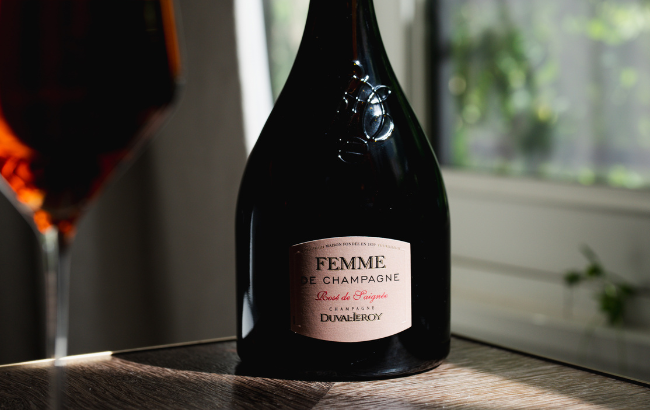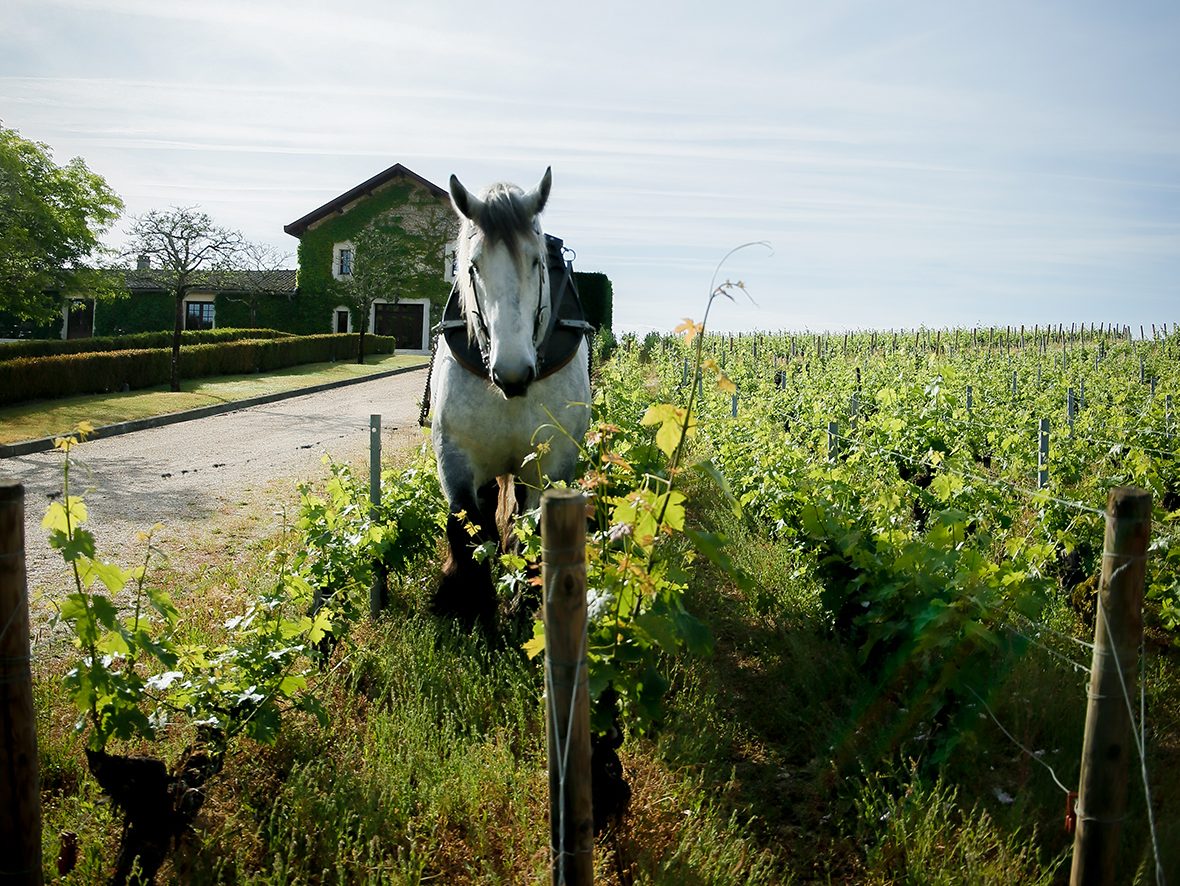This website uses cookies so that we can provide you with the best user experience possible. Cookie information is stored in your browser and performs functions such as recognising you when you return to our website and helping our team to understand which sections of the website you find most interesting and useful.
Koshu: the go-to grape for Japanese food
By Patrick SchmittExciting things are happening in Japanese winemaking, especially when it comes to the Koshu grape, which is being made into expressions that uniquely complement the country’s raw-fish dishes. By Patrick Schmitt MW.
Koshu growing at Suntory’s Tomi no Oka winery in Yamanashi
For any newcomer to a crowded international wine market, speedy success is predicated on two things: simplicity and inimitability. The former makes you memorable, and the latter makes you necessary. It’s why Argentine Malbec has ploughed its way into seemingly saturated wine-loving nations. Or, predating that, New Zealand Sauvignon Blanc. Both bring something uncomplicated that, stylistically at least, hasn’t been seen before or, despite attempts at copying, since.
I mention both of these examples because we have a new one breaking into the global wine scene that offers a similarly strong combination. It is the unforgettable and unique union of the fast-developing Japanese wine industry and the little-known Koshu grape. Japanese Koshu is more exotic than the two examples mentioned, because wine consumers in the UK and the US, have, for the most part, tried neither the output of Japan’s vineyards nor the Koshu grape. Both are novelties. Put them together, and they are an exciting proposition – and here’s why.
The first reason relates to the rapid emergence of Japan’s domestic wine industry. Although the country has been producing wine for almost 150 years, it is only recently that the nation has started to develop exports, a decision prompted by a new pride in its own wines, following fresh rules that came into effect last month, stipulating that Japanese wine must come from grapes grown in Japan (much of the wine production in the country employs imported grapes or must, which, before the new laws, could be labelled as Japanese).
While Japan works with a number of grape varieties, from widely planted hybrid red grape Muscat Bailey A to international varieties such as Merlot, Pinot Noir and Cabernet, and in whites, increasing amounts of very good Chardonnay, it is the Koshu grape that’s become the primary focus for Japanese vignerons looking to stand out in the market at home and abroad.
Challenging climate
Koshu grapes are protected from summer rainfall with little wax paper hats stapled together above each bunch
The decision to select Koshu stems initially from its long-time presence in Japan, along with the variety’s suitability to the country’s climate – a challenging one for cultivating grapes because of rain during the growing season. The main vine-growing areas of Japan are, after all, based in a sub-tropical climate, albeit relatively dry examples of such prevailing weather systems.
Koshu is believed to have arrived in Japan via the Silk Road from the Caucasus around 1,000 years ago, but it wasn’t until the 1870s that the grape was used to make wine – it had previously been grown for eating. But the use of Koshu is inextricably linked to the birth of the Japanese wine industry, because the country’s first bottles of wine were made with the grape, and hailed from the city of Kofu – in the heart of the Yamanashi wine region, where to this day, 95% of all Koshu is grown.
It is a hybrid grape, believed to have originated naturally by a crossing of the European Vitis vinifera and an Asian Vitis species. It excels in Japan’s humid conditions, and produces wines of finesse. In 2009, Koshu of Japan was founded to champion the grape, and in 2013 it was recognised by the OIV, adding greater impetus to Japanese wine producers to promote the variety more widely.
There is something so distinctly Japanese about it too. In part, this relates to its appearance. With beautiful deep-pink berries, it complements the slightly paler shades of the cherry blossoms that Japan is so famous for.
Not only that, but its primary growing area, Yamanashi, is overshadowed by the perfectly cone-shaped, snow-capped, volcanic wonder that is Mount Fuji – the most powerful visual symbol of Japan. Combine the translucent pink of Koshu with the instantly recognisable background of Mount Fuji on a clear day, and you have an image so striking, any wine lover will not only remember it, but will want to try the product featured within it.
Then there’s the growing technique. In keeping with Japan’s reputation for precision in technology, the country’s viticulturists go to extraordinary lengths to protect the Koshu grapes, choosing to train them high in pergolas, improving airflow around the bunches, while also shading the grapes from temperature extremes. They also protect the Koshu grapes from summer rainfall with little wax paper hats stapled together above each bunch, ensuring that the water doesn’t get inside the bunches. Otherwise, the water might start the spread of rot, which would spread rapidly in this warm and damp climate.
It’s an effective, if quite expensive technique, not used anywhere else in the world. As for the rainfall that does wash onto the ground, the free-draining soils of the Yamanashi area, many of them volcanic in origin, ensure that the berries themselves don’t swell too much, preventing the resulting wines from suffering from dilution.
Nevertheless, Koshu-based wines are delicate. Naturally around 11% ABV – and rarely above 12% – they are never tiring to drink, or forceful in character, but deliver something subtly intriguing. As we reported in an article last month that focused on introducing the Japanese wine scene as a whole, the wines made from Koshu tend to have a combination of flavours, from citrus to yellow fruit, and in general, to draw comparisons with well-known European whites, have some of the flavours of Muscadet, with its freshness and breadiness – the Japanese tend to give Koshu relatively extended lees contact – but also Albariño, with its lime-acid and peach fruit. Koshu also has something more unique, in the form of a gentle salty note, as though someone has added a drop of soy to the glass.
Emblematic grape
Tasting Koshu with Chateau Mercian’s Mitsuhiro Anzo
So, pale pink berries in the shadow of Mount Fuji, grown with painstaking attention to detail, and producing something that’s delicate, fresh and with a touch of umami – one can imagine why Japanese Koshu should become emblematic of this nation’s fast-emerging wine industry. It’s also why drinkers from around the world should be so intrigued.
And there’s more to entice consumers. Koshu comes in a range of styles, ensuring it matches different tastes, and rewards exploration. Some of this diversity relates to particular sites, where certain aspects and soils – particularly if they are free-draining – produce wines of great intensity and individuality. One of these is the Misawa vineyard in Akeno, where celebrated Koshu producer Grace makes the most of high altitude – coupled with, unusually, vertical shoot position training – to produce a remarkably intense, peachy Koshu. Another, the Isehara vineyard from brilliant Koshu producer Katsunuma, yields a sought-after example bursting with pink grapefruit, not unlike a top-end Sauvignon Blanc from the Loire.
However, much of the most obvious variations in Koshu wine style comes from practices in the cellar. As mentioned above, lees contact can be used to build in a bready complexity, as well as more texture to the naturally light-bodied wine, and with great success – much like the techniques used in Muscadet with the delicate Melon de Bourgogne grape.
Barrel fermentations and ageing, including new oak, albeit in low proportions, can yield surprisingly successful results with this subtle variety. The peanut character derived from high-quality barriques seems to marry well with the lemon and stonefruit flavours of Koshu, in the same way sweet oak complements ripe Sauvignon Blanc in Bordeaux. Grande Polaire produces a successful example, but in my view, the ultimate barrel-influence Koshu comes from Katsunuma Winery – called Aruga Branca Pipa. To carry with the oak-sourced flavours, this producer freezes the grapes to concentrate the peach and grapefruit notes in its best Koshus.
But it’s not just isolating particular plots or playing with lees and oak contact in the cellar that yields different expressions of Koshu. Some of the most notable wines come from extended skin contact – Koshu produces particularly good ‘orange wines’, coming in a range of hues, from light amber to egg-yolk coloured, cloudy wines. Gently grippy, often with aromas of smoked tea leaves, these are complex, versatile expressions that are gaining popularity in Japan, where there is a strong demand for ‘low-intervention’ wines (more so than organic or biodynamic certified products). Mercian and Lumière make particularly good skin-contact Koshus.
A further interesting and refreshing use for Koshu is in the creation of sparkling wines. Lumière crafts a delicious traditional method fizz with the grape, with the persistent mousse augmenting the citrus freshness of Koshu on the palate. In short, there’s almost nothing that Koshu makers haven’t tried, with the new wave of winemakers now also looking to make Koshu with no added sulphur, as well as trialling new fermentation vessels, from concrete eggs to amphorae – yes, the experiments common in the cellars of Western Europe are also to be found in this far-Eastern outpost for winemaking.
It’s not just curiosity that is motivating Japanese Koshu producers, whose spiritual home is Yamanashi, to try new things with this grape. They are driven by a desire to create wines that will pair successfully with the full range of flavours in Japanese cuisine, from the extremely delicate to the strong and challenging. One aspect that’s clear, however, is the brilliant combination of the salty citric nature of Koshu and Japan’s raw-fish-based food.
Partner Content
This may be by accident, rather than design, but it is real; the tangy Koshu wines enliven the palate after sashimi, preparing the mouth for a dashi dish, or cutting through the residue of sticky rice in sushi. The Koshu helps with the consumption of such food, and the salty character of the dishes elevates the Koshu, bringing out more intensity.
And the likes of sparkling Koshu is an ideal accompaniment to the more subtle styles of raw fish-based Japanese food, where traditionally promoted wine matches such as oily Pinot Gris or aromatic Gewürztraminer would overpower such cuisine. However, where the much more powerful dashi-flavoured fare is on offer, requiring something weightier, one can opt for a Koshu expression with extended lees-contact or some additional skin contact.
A successful discovery
Koshu’s subtle appeal, complexity, and ability to pair so successfully with one of the world’s most popular and revered cuisines – Japan’s raw-fish-based food – are all reasons to want to try this grape. Pictured: Shigekazu Misawa (left) with Patrick Schmitt MW
One remarkable pairing is the intensely salty, creamy sea urchin – called ‘uni’ – with a Koshu orange wine. Another extraordinarily successful discovery for me was roast Wagyu beef and ginger paired with the aforementioned Aruga Branca Pipa from Katsunuma – proving the versatility of this grape, grown in Japan for around nine centuries before its winemaking capabilities were realised.
So, Koshu’s subtle appeal, complexity, and ability to pair so successfully with one of the world’s most popular and revered cuisines – Japan’s raw-fish-based food – are all reasons to want to try this grape. But there’s a further reason why it should be on the shelves and lists of specialist wine retailers and great restaurants respectively. And that’s because it is right on trend with demand in mature wine-drinking markets, where the call is for something light in body, low in alcohol, refreshing, and authentic. Japanese Koshu ticks all these boxes.
Add to these traits the elegantly understated packaging of the wines, the charming and reserved nature of the winemakers, and the fact that the combination of Koshu and Japan is not only easy to remember, but also singular, means you have something relatively new to the international wine scene that is ripe for enthusiastic take-up.
Indeed, any great wine-focused restaurateur or retailer without at least one reference for Japanese Koshu is no longer fully representing the wine styles of the world. And any serious Japanese restaurant without a broad palette of Koshu wines, is failing to offer its customers one of the best accompaniments to its specialist fare. Not only that, but a wine that shares the same source nation with its culture of precision and subtlety that goes into the production of the best raw-fish food in the world.
So, the next time you’re offered a glass of Gewürztraminer with your sashimi, politely tell the sommelier that you would rather have a carafe of Koshu. And, if they can’t supply it, please spread the word that this is the go-to grape for Japanese food – as well as one of the most exciting newcomers to the wine world in this century, even if its origins can be traced back to the beginning of the last.
Koshu: key points
• It is thought that Koshu’s origins in Japan can be traced back to 1186 when it was discovered growing wild at Katsunuma in Yamanashi prefecture.
• It is a hybrid grape, believed to have originated naturally by a crossing of the European Vitis vinifera and an Asian Vitis species.
• According to Wine Grapes (Robinson et al), Koshu’s DNA profile does not match any other known variety and its exact origin remains unknown.
• Koshu produces medium-sized bunches of large, thick-skinned, pink-tinged berries.
• The grape has been favoured for a long time in Japan’s humid climate because it is resistant to botrytis bunch rot. > Koshu is Japan’s most planted grape, and 95% of plantings are found in Yamanashi prefecture.
• Koshu produces delicate white wines that rarely exceed 12% ABV.
• The grape can also be used to produce richer versions when grown in low-yielding sites, or if cellar practices allow – with techniques including extended skin contact and/or lees contact, barrel fermentation and cryoextraction.
• The grape can also be used to make quality sparkling wine.
• Its range of styles, from the lightest to fullest, are particularly good complements to Japanese raw-fish cuisine, from subtle types to the salty, creamy sea urchin ‘uni’.
• In 2009, Koshu of Japan was founded to champion the grape, and in 2013, Koshu was recognised by the OIV.





